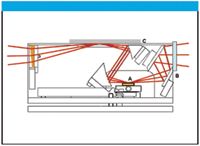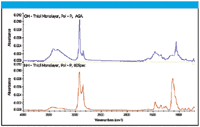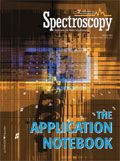Measurement of Monomolecular Layers with Specialized FTIR Grazing Angle Accessories
PIKE Technologies
Monomolecular layer samples have traditionally been a challenge for spectroscopic measurements. Specular reflectance at high "grazing" angles (around 80 degrees from normal to the surface) has been recognized as one of the best spectroscopic techniques to monitor monomolecular layers on reflective surfaces due to the enhancement of the infrared signal (1, 2). The versatility of this sampling technique is further optimized using different specialized grazing angle accessories.

Experimental
An FTIR spectrometer was equipped with an MCT detector and with three different grazing angle accessories; an 80Spec™ - fixed grazing angle, an AGA™ - variable illumination area and with a VeeMAX™ - variable angle reflectance accessory. The fixed angle 80Spec is a dedicated single reflection accessory with simple input and output optics channeling the infrared light with two gold flat mirrors. While this is a powerful tool, its use is limited to larger area samples. When the light from an FTIR instrument is directed to the sample at a high angle, the illuminated area is not as well controlled, its shape is elongated and the IR image size becomes relatively large. When the sample is smaller than the illuminated spot, apertures could be used to limit the size of the infrared beam. In this case, however, the contrast and repeatability of the measurement usually suffers considering the sensitivity required to detect monomolecular quantities of materials. The controlled projected image size therefore is a very important advantage of the AGA accessory, which has a special imaging system with a set of variable diameter mirrors. In this unique optical design, the illuminated spot on the sample is the same as the size and shape of the gold mirror at the base of the optical layout (Figure 1). The selector mirrors in this design are round and are variable in five steps from 3 mm to 12.5 mm diameter.

Figure 1. In this unique optical design, the illuminated spot on the sample is the same as the size and shape of the gold mirror at the base of the optical layout.
The variable angle VeeMAX accessory (Figure 2) on the other hand allows other reflectance and reflectance-absorbance measurements in addition to grazing angle measurements.
All three optical arrangements can be used with additional polarizers to enhance the monomolecular surface species. In this work, a ZnSe wire grid polarizer was used for all samples. All measurements were done using the MCT detector as the IR throughput is relatively low at grazing angle of incidence in combination with an IR polarizer. All spectra were collected at 8 cm-1 resolution with a 1 min data collection time.

Figure 2. The variable angle VeeMAX accessory.
Results and Conclusions
For the comparison of the performance of different optical geometries, monolayer systems used in various biotechnologies were selected. Monolayers are considered initial surface coverages with reactive groups to be modified further for various biospecific and ligand interactions, fabrication of protein, DNA and carbohydrate chips, and biosensors. Gold is known to have high affinity to sulfur containing groups, such as thiols, and generate more or less well-ordered monolayers (4). One of the systems, a self assembled hydroxyl-terminated alkanethiolate monolayer that was formed on a freshly evaporated gold surface using the method and materials from Platypus Technologies, Inc (Madison, Wisconsin, http://www.platypustech.com). The monomolecular layer is formed over a timeframe of several h in a dilute solution of HS(CH2)n (OCH2CH2)nX, where X can represent different functional groups. The ω-functionalized alkanethiolate layer (5) was stable throughout the experiment and was easily measured on all of the accessories.

Figure 3. (3A) shows the NH-terminated monolayer measured on the 80Spec with a ZnSe polarizer. Figure 3B shows the example using the AGA is an OH-terminated thiol.
Figure 3A shows the NH-terminated monolayer measured on the 80Spec with a ZnSe polarizer. The example shown using the AGA is an OH-terminated thiol (Figure 3B). The accessory was adjusted to project a 12.5 mm diameter spot on the gold-coated slide. Due to the better definition of the illuminated area, smaller samples can be measured easily without apertures which in some cases can introduce artifacts. Grazing angle measurements with the VeeMAX is shown with a third kind of monolayer, a CH-terminated alkanethiol. -CH terminated alkanes are generally more difficult to identify, due to the lack of characteristic differentiating molecular groups in comparison to organic contamination from ambient air, solvents on the sample or the background slides. For the experiment the VeeMAX was set to 78 degrees and produced the characteristic pattern seen in Figure 4.

Figure 4. For the experiment the VeeMAX was set to 78 degrees and produced this characteristic pattern.
Conclusions
Infrared spectroscopic measurements of monomolecular layers can be performed using all of the different grazing angle reflectance accessories discussed in this work and are capable of producing excellent quality spectra. The intensity of the mono-molecular signal may be enhanced with polarized light, and the quality of the result is greatly enhanced by using an MCT detector. By controlling the illuminated area with a special optical design of the AGA, one can measure small samples or examine small areas of larger samples. When, in addition to grazing angle analysis, other reflectance measurements are needed; the variable angle VeeMAX is an excellent choice.
References
1. F.M. Mirabella, Modern Techniques in Applied Molecular Spectroscopy, (John Wiley & Sons, New York, 1998).
2. R.J. Greenler, J. Chem. Phys. 44, 10 (1966).
3. Single Adjustment Specular Reflection Accessory for Spectroscopy, U.S. Patent 5,106,196.
4. C.M. Pradier, M. Salmain, Z. Liu, and C. Methivier, Surf. Interface Anal. 34, 67–71 (2002).
5. Ulman, A. Chem. Rev. 96, 1533–1554 (1996).
PIKE Technologies
2901 Commerce Park Drive, Madison, WIÂ 53719
Tel. (608) 274-2721, Fax (608) 274-0103

Thermo Fisher Scientists Highlight the Latest Advances in Process Monitoring with Raman Spectroscopy
April 1st 2025In this exclusive Spectroscopy interview, John Richmond and Tom Dearing of Thermo Fisher Scientific discuss the company’s Raman technology and the latest trends for process monitoring across various applications.
A Seamless Trace Elemental Analysis Prescription for Quality Pharmaceuticals
March 31st 2025Quality assurance and quality control (QA/QC) are essential in pharmaceutical manufacturing to ensure compliance with standards like United States Pharmacopoeia <232> and ICH Q3D, as well as FDA regulations. Reliable and user-friendly testing solutions help QA/QC labs deliver precise trace elemental analyses while meeting throughput demands and data security requirements.